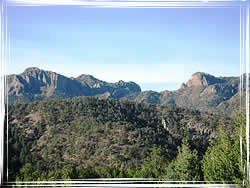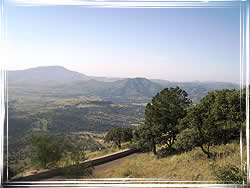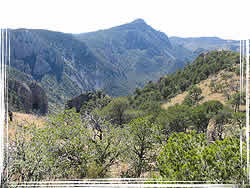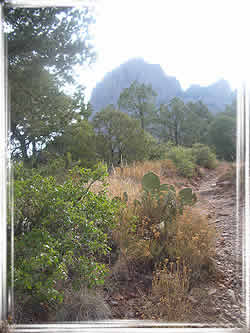Texas Eco-Regions
Mountain Forestback to Eco-Regions Map
Elevation
Elevations range from 5,000 to 8,700+ feet above sea level. The tallest mountain in Texas, Guadalupe Peak stands at 8749 feet.
Precipitation
Rains come in the summer usually July through September with occasional winter snow at the higher elevations giving the mountains a 12 to 20 inch average. In higher elevations, more precipitation occurs, therefore greater vegetation occurs. The Guadalupe Mountains have on average the greatest amount of rainfall at 21.06 inches per year, while the Chisos Mountains in Big Bend National Park receive about 15.34 inches a year.
Topography
Topography plays a major role in vegetation; north and east facing slopes have taller and more vegetation than on south or west facing slopes. At higher elevations, ponderosa pines and southwestern white pines occur on north and eastern slopes, while across the canyon, pinyon pines and oaks dominate. At lower elevations oaks and junipers occur on north and east facing slopes and yucca, agaves and grasses on the west and south facing slopes.
Soils
The mountains of West Texas are usually igneous and/or sedimentary (most of which is limestone in origin). The soils are mostly shallow and rocky; however, the canyon bottoms and small valleys have deeper soils.
Vegetation Description
The mountains of the Southwest and far west Texas are often described in text books as sky islands. There are six peaks in the Trans-Pecos with elevations over 8,000 feet. There small pockets of junipers, oaks, soapberries, and netleaf hackberry can be found. Ashes and cottonwoods grow adjacent to a permanent water source such as a seep or spring. An abundance of desert scrub with sotol, yuccas, grasses, agaves, sumacs, and other Chihuahuan desert vegetation exist on the south and west facing slopes.
Coniferous forests are found in the larger, taller, wetter ranges, like the Guadalupe, Davis and Chisos Mountains. Vegetation in these mountains is indicative of wetter times when the conifers of the Southern Rockies and the Mexican ranges of the Sierra Madre Occidental and Oriental were more common throughout the region. Even though the species of vegetation may be different, the associations will be the same. Oak-juniper-pinyon is one of those associations .
Impacts of Fire
Most fires in the Trans-Pecos region are started by lightening strikes, which are common during the summer storms. These fires have kept juniper, pinyon pine and oak at bay at the higher elevations and desert scrub reduced at the lower elevations. In some areas, however, overgrazing of cattle, years of drought and the lack of fire has allowed for the encroachment of juniper, mesquite and other invasive vegetation, which are now replacing the once-dominant grass.
Historical Information
Permanent Spanish settlements were established on the south side of the Rio Grande river around 1659 in Paso Del Norte (now known as El Paso on the United States side of the river and Ciudad Juarez on the Mexican side.) The areas beyond the river were home to the Mescalero and Lipan Apache tribes, who were nomadic throughout the region. The Comanche’s controlled the eastern edge of the region. After Texas joined the Union in 1845, with the protection of the U.S. Army stationed in the outposts of Fort Stockton, Fort Davis, Fort Hancock and Fort Bliss, the rich, vast expanses of grasses brought in ranchers in the mid- to late 19th century. These early settlers obtained large sections of the Trans-Pecos where many of their descendants still own and occupy much of the area. Mining for cinnabar in the Big Bend area was profitable for a while. Logging was never done on a large scale in these sky islands; but there was at least one small, short-lived sawmill that provided timbers for shoring in the mining industry and wood for Fort Davis.
Agriculture has always been a major part of the settlements along the Rio Grande with early inhabitants growing grapes and fruit trees. Paso Del Norte was also a major stop to replenish supplies along the El Camino Real a major trade route between Mexico City and Santa Fe, New Mexico .
Other
Today, the Big Bend region is benefiting from eco-tourism. Two national parks, Guadalupe and Big Bend, are major attractions for nature lovers. McDonald Observatory is a great destination for star gazers. Marfa is becoming known for its art community. Fort Davis is rich in history following the restoration of the Fort. Presidio and El Paso are gateways into Mexico.





